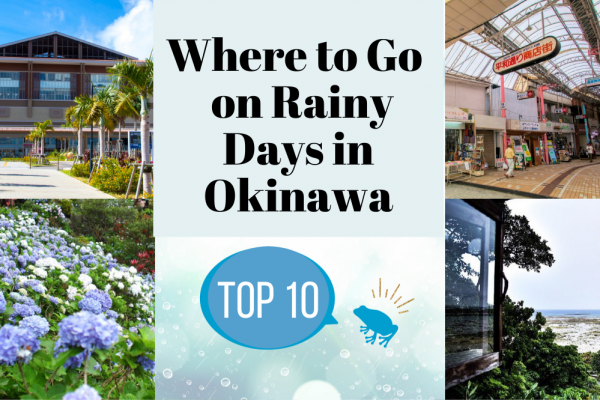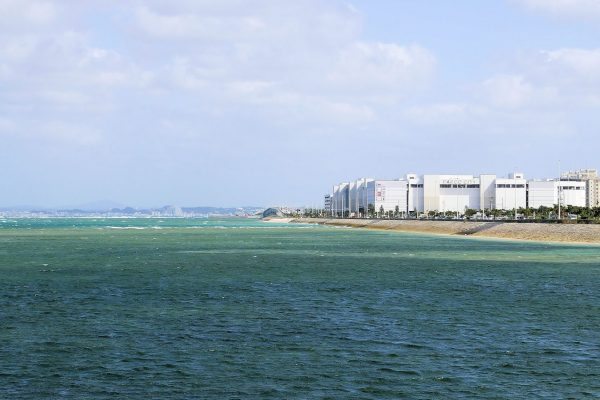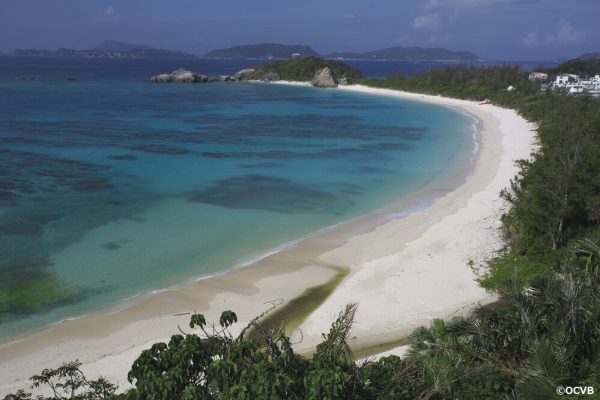Temperature & Clothing Calendar
Even in Okinawa’s warm climate, summer and winter clothing differs slightly, so be sure to check before your trip!
January
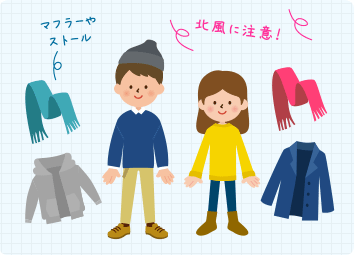
Weather Information
- Average Temperature: 17.0℃
- Highest Temperature: 19.5 ℃
- Lowest Temperature: 14.6 ℃
- Average Sea Temperature: 21 ℃
- Amount of Rainfall: 107.0mm
- Hours of Daylight: 94.2 hours
Although Okinawa is known for its warm weather, during this season the temperature drops just as it does in Honshu in Mainland Japan. Strong northern winds make it feel even colder than the actualy temperature. It is recommended that you wear a warm long sleeve top and put on a coat or hoodie that you can take off when the winds weaken and the sun comes out. Boots are also recommended. As rainfall is low, its the perfect time to visit places like historical sites.
February
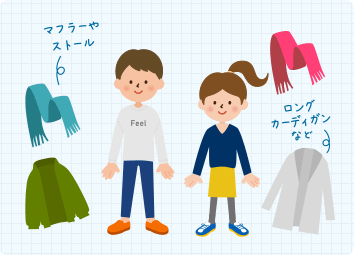
Weather Information
- Average Temperature: 17.1℃
- Highest Temperature: 19.8℃
- Lowest Temperature: 14.8℃
- Average Sea Temperature: 22℃
- Amount of Rainfall: 119.7mm
- Hours of Daylight: 87.1 hours
In January, cold weather continues due to the prevailing strong northern winds. Cherry blossoms are a highlight of this season. A thin long sleeve top and wind breaking outerwear that can be removed if it gets sunny are recommended. Warm pants, sneakers, and boots are suitable for this time. There may be light rain showers so it is advisable to carry a folding umbrella.
May
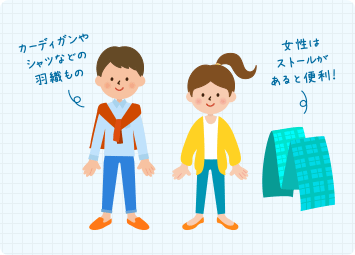
Weather Information
- Average Temperature: 18.9℃
- Highest Temperature: 21.7℃
- Lowest Temperature: 16.5℃
- Average Sea Temperature: 22℃
- Amount of Rainfall: 161.4mm
- Hours of Daylight: 108.3 hours
There are days when the temperature goes over 20 degrees celsius (68 degrees fahrenheit) but the weather gets more comfortable each day. However, there are times when it gets cold all of a sudden, so please be aware of the fluctuating temperatures. Some people wear short sleeve shirts but it is best to wear a thin long sleeve shirt and something to wear over it. Long pants and shoes that are appropriate for springtime are recommended. Around this time the UV rays start to get stronger, so UV protection is a must.
April
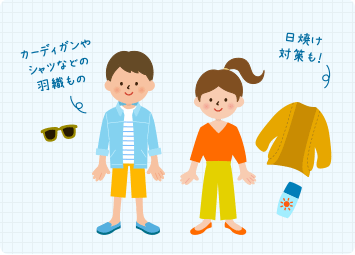
Weather Information
- Average Temperature: 21.4℃
- Highest Temperature: 24.1℃
- Lowest Temperature: 19.0℃
- Average Sea Temperature: 23℃
- Amount of Rainfall: 165.7mm
- Hours of Daylight: 123.8 hours
There are days when the temperature goes over 20 degrees celsius (68 degrees fahrenheit) but the weather gets more comfortable each day. However, there are times when it gets cold all of a sudden, so please be aware of the fluctuating temperatures. Some people wear short sleeve shirts but it is best to wear a thin long sleeve shirt and something to wear over it. Long pants and shoes that are appropriate for springtime are recommended. Around this time the UV rays start to get stronger, so UV protection is a must.
May
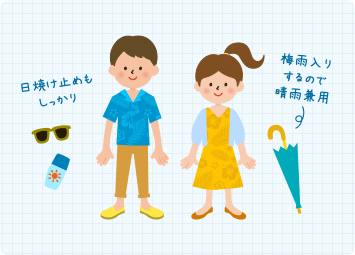
Weather Information
- Average Temperature: 24.0℃
- Highest Temperature: 26.7℃
- Lowest Temperature: 21.8℃
- Average Sea Temperature: 24℃
- Amount of Rainfall: 231.6mm
- Hours of Daylight: 145.8 hours
The rainy season begins during the second half of Japan’s Golden Week holidays. The weather is hot and humid, so it is best to wear short sleeve and sleeveless tops made of breathable material. People begin to wear kariyushi shirts (similar to aloha shirts) around this time. Although it is rainy season and lots of rain is expected, there are actually more sunny days than might be expected. UV rays are strong so it is recommended that you protect yourself with an umbrella with UV protection and sunscreen.
June
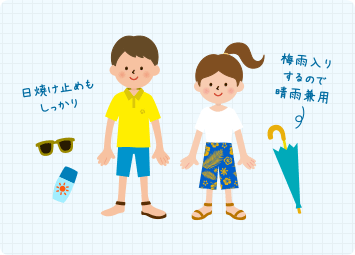
Weather Information
- Average Temperature: 26.8℃
- Highest Temperature: 29.4℃
- Lowest Temperature: 24.8℃
- Average Sea Temperature: 26℃
- Amount of Rainfall: 247.2mm
- Hours of Daylight: 163.6 hours
Rainy season will continue until the middle of the month. It gets even more humid than May but once the rainy season ends, summer officially begins. Deal with the heat by wearing shorts, sandals, and summer outfits. However, be aware that most buildings are air-conditioned so you may feel cold while inside. It is recommended that you bring along a jacket. You can enjoy marine leisure activities at beaches and go to the beach in your favorite swimsuit.
July
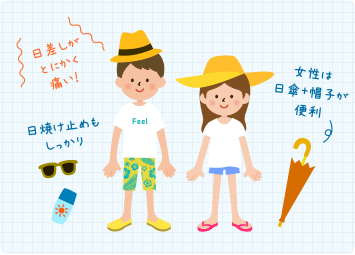
Weather Information
- Average Temperature: 28.9℃
- Highest Temperature: 31.8℃
- Lowest Temperature: 26.8℃
- Average Sea Temperature: 28℃
- Amount of Rainfall: 141.4mm
- Hours of Daylight: 238.8 hours
From beaches to food to culture, this is the best time to enjoy Okinawa’s summer to the fullest. Compared to August and September, there are fewer typhoons in July. Even on hot days you can feel the cool breeze while in the shade. However, UV rays are extremely strong during this month and sunglasses, hats, sunscreen and other sun protection are necessary. It is also recommended that you carry around something to drink and keep hydrated to prevent heat stroke. Try to wear breathable clothing to keep cool.
August
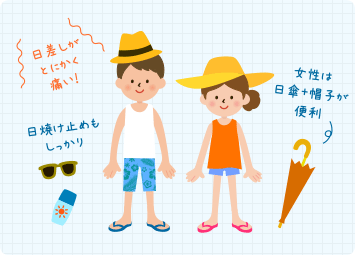
Weather Information
- Average Temperature: 28.7℃
- Highest Temperature: 31.5℃
- Lowest Temperature: 26.6℃
- Average Sea Temperature: 29℃
- Amount of Rainfall: 240.5mm
- Hours of Daylight: 215.0 hours
Tourist spots in Okinawa are the most crowded during this month. There are summer events and eisa festivals held throughout Okinawa. Compared to July, there is much more rainfall this month, but this is due to the influx of typhoons. If you plan to visit Okinawa during this month, please take into consideration the effects of typhoons and plan a flexible itinerary. Just as in July, it is best to wear breathable clothing and take measures to prevent sunburn and heat stroke.
September

Weather Information
- Average Temperature: 27.6℃
- Highest Temperature: 30.4℃
- Lowest Temperature: 25.5℃
- Average Sea Temperature: 29℃
- Amount of Rainfall: 260.5mm
- Hours of Daylight: 188.9 hours
Although the temperature decreases slightly , summer-like weather continues. You can wear summer clothes like short sleeve shirts, sleeveless tops, shorts, and sandals with no problem. Thorough sunburn and heat stroke prevention measures are necessary. However, toward the end of the month the weather may get more fall-like. The amount of rainfall and typhoons is the highest during this month. Just as in August, plan a flexible schedule.
October
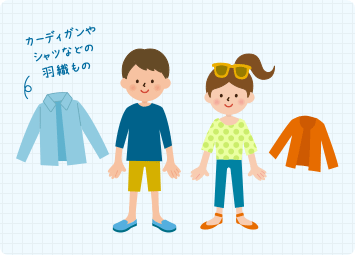
Weather Information
- Average Temperature: 25.2℃
- Highest Temperature: 27.9℃
- Lowest Temperature: 23.1℃
- Average Sea Temperature: 28℃
- Amount of Rainfall: 152.9mm
- Hours of Daylight: 169.6 hours
Typhoons decrease and the weather stabilizes. It is still hot during the day so summer clothing can still be worn, but it can get cold during the mornings and evenings so it is good to have a cardigan, long sleeve shirt, or jacket. At the beginning of the month the sea temperature is still high so you can thoroughly enjoy marine leisure activities. As the temperature decreases significantly, this is a good time for sightseeing and camping.
November
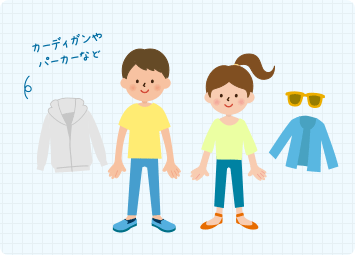
Weather Information
- Average Temperature: 22.1℃
- Highest Temperature: 24.6℃
- Lowest Temperature: 19.9℃
- Average Sea Temperature: 25℃
- Amount of Rainfall: 110.2mm
- Hours of Daylight: 123.0 hours
Rainfall is low and there are fewer tourists so you can enjoy visiting historical sites and shopping at a relaxing pace. As there is a sudden drop in sea temperature, it is best to avoid marine leisure activities. During the day it is hot enough to get sweaty so a t-shirt, long pants, and sneakers are the most comfortable attire. As it can get chilly, it is recommended that you bring a cardigan or fall jacket.
December

Weather Information
- Average Temperature: 18.7℃
- Highest Temperature: 21.2℃
- Lowest Temperature: 14.4℃
- Average Sea Temperature: 23℃
- Amount of Rainfall: 102.8mm
- Hours of Daylight: 115.6 hours
Along with November, this is a great month to enjoy leisurely sightseeing. However around this time the northern winds get strong and it feels colder than the actual temperature. A thin long sleeve shirt and long pants along with a jacket or coat for when it gets windy are ideal. For footwear, sneakers and boots are recommended.



